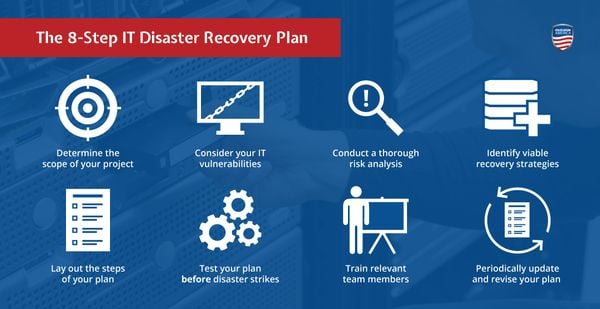
Data Storage Solutions, Disk Array and Network Storage for Servers
February 4, 2019
Data Center Trends in 2019
February 6, 2019Successful businesses expect the unexpected—and plan accordingly. Do you have a disaster recovery plan in place?

From wildfires in California to hurricanes on the Gulf Coast, natural disasters have had an indelible impact on countless American communities over the course of the last year. What’s more, once the wall-to-wall news coverage subsides and their plight fades from public consciousness, victims of tragedies like these must contend with a long, challenging journey to rebuild their communities.
As is the case for individuals and families, getting up and running in the wake of a disaster can be incredibly daunting for many businesses. With the Federal Emergency Management Agency reporting that 40 percent of small businesses never fully recover from natural disasters, planning for the worst is, in fact, best practice. While no amount of foresight can prevent hurricanes, wildfires, or earthquakes from impacting your company, drafting a disaster recovery plan—and knowing how to enact it—can be the difference between shuttering your doors for good and reopening them in a matter of weeks.
Despite this reality, only 25 percent of small businesses have a business continuity plan in place. Granted, business continuity and disaster recovery aren’t one and the same, but the fact of the matter is that preparing (and refining) a disaster recovery plan is a must—especially when it comes to protecting critical IT infrastructure.
As businesses grow increasingly reliant on high-performing networks and sprawling datasets to deliver value to clients, IT protection has become an outsized component in many disaster recovery plans. If you and your team are preparing to draft a plan of your own, make sure you carefully consider the following eight steps. https://www.youtube.com/embed/JcSpjHKxJYY
1. Determine the Scope of Your Project
First, you need to understand what your end goal is. If you’re a company that’s completely dependent on quick and easy access to your data to stay in business, your IT disaster recovery plan should focus on ensuring your proprietary information is kept safe and secure—even if your onsite hardware experiences critical failures. For most small and mid-sized businesses, this means exploring offsite data storage options like public cloud storage and/or data center colocation.
2. Consider Your IT Vulnerabilities
After articulating your end goal, you need to develop a comprehensive understanding of your most glaring vulnerabilities, paying particular attention to the historical disaster risks in your geographic region. While the best disaster recovery plans aim to protect as many assets as possible, you’ll likely have to make difficult prioritizing decisions in order to ensure that the most important facets of your business aren’t at risk.
If, for example, your number one concern is your onsite hardware and the most common natural disaster in your area is flooding, protecting your hardware from water damage—and having contingency plans in place in the event these protections fail—is of paramount importance.
3. Conduct Risk Analysis
At this juncture, you should already know what your vulnerabilities are and have put safeguards in place to counteract them, but you might not know exactly how these safeguards will respond in a crisis. This is when risk analysis comes into play.
Conducting a thorough risk analysis is tantamount to performing a “stress test” designed to help you understand precisely how vulnerable you are given your current counter-disaster infrastructure. By gaining this perspective, you’ll be better positioned to protect your most valuable assets.
4. Identify Recovery Strategies
After stress testing your safeguards, the next move is to identify the most efficient and cost-effective recovery strategies. Ideally, this calculus will take account of both your most pressing IT vulnerabilities and the performance of your safeguards during your risk analysis.
If, for instance, you’ve determined that your onsite data storage is your greatest vulnerability, you should map out the most efficient way to migrate data stored in a public cloud or colocation center back into your system after disaster strikes.
5. Draw up a Plan

At this point, you’re ready to begin assembling your IT disaster recovery plan in earnest. This will involve collecting the insights you’ve gathered and codifying them in an easy-to-understand, sequential guide.
For example, if you’ve opted to entrust a public cloud provider with the storage and management of your data, your disaster recovery plan should clearly lay out the steps that need to be taken to contact the provider and get your IT environment back online after a critical systems failure.
6. Test Your Disaster Recovery Plan
Drawing up an IT disaster recovery plan is a step in the right direction—and, as illustrated above, probably puts you ahead of many of your competitors—but once you think you have everything in place, it’s important to test your plan to ensure that each step unfolds as intended. After all, the best time to figure out that your recovery plan needs work is before disaster strikes—not after.
7. Train Team Members
Once you’re confident in your plan, it’s time to introduce it to your team. Ideally, you’ve been consulting with key personnel throughout the previous six steps, but regardless of the degree of collaboration in your planning process, it’s incumbent on you to ensure that everyone in your organization knows what will happen in the event of a flood, hurricane, wildfire, or any other catastrophe.
In fact, bringing your employees into the loop is a great way to get your plan vetted by people with diverse perspectives, who may be able to spot something you’ve overlooked.
8. Update and Revise Your Plan
f course, while we all hope we never have to put our IT disaster recovery plan into action, it’s worthwhile to regularly revisit and, if necessary, revise your plan. Does it still make sense in light of changes to your operations?
Have vendors introduced any new products or services that you want to incorporate into your recovery plan? By asking these kinds of questions, you can update your plan as needed—and be sure you’re prepared if and when the next natural disaster strikes.

